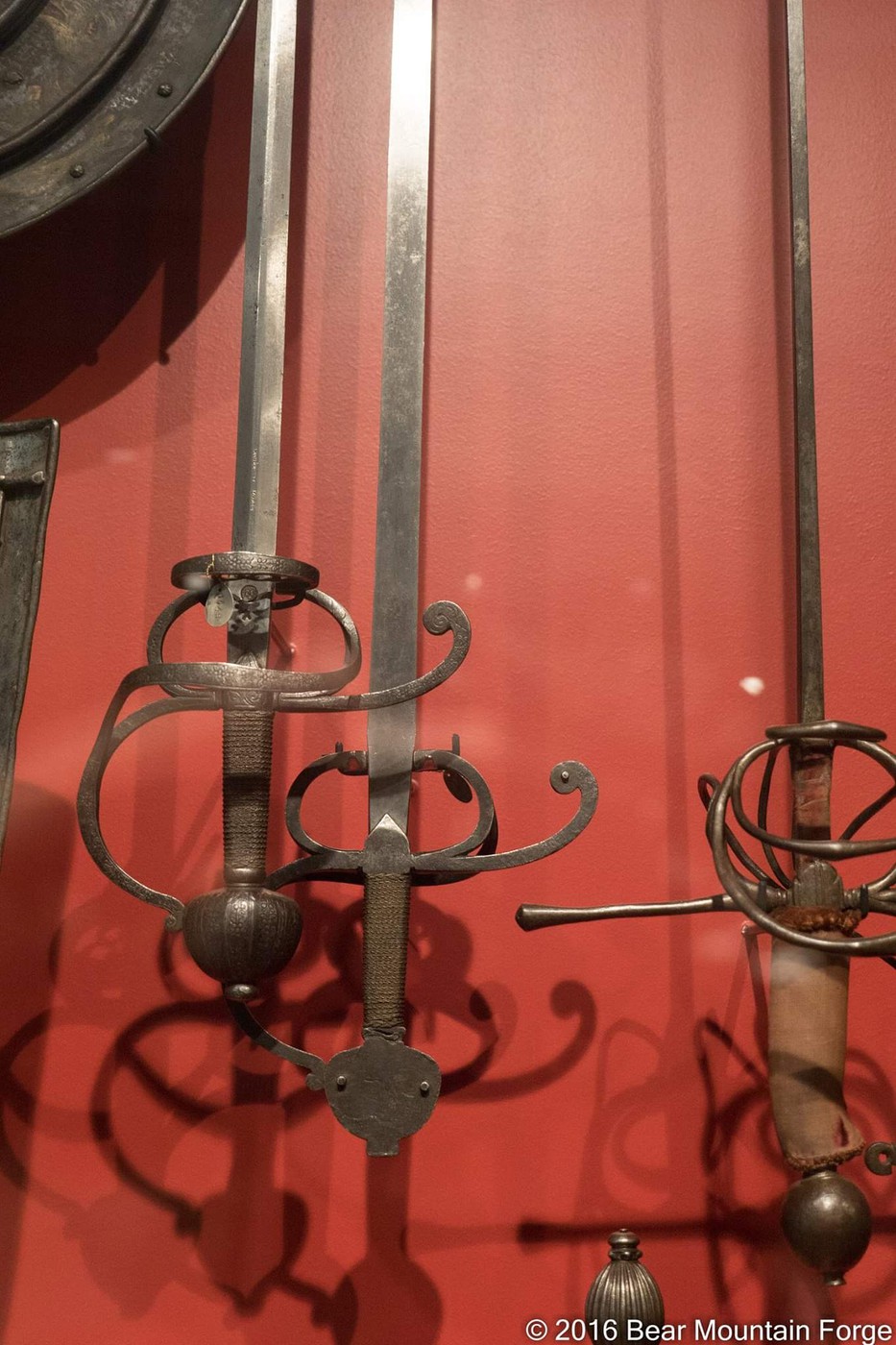| Author |
Message |
|
Toni Leivonen
Location: Finland Joined: 20 Jul 2014
Posts: 16
|
 Posted: Tue 11 Jun, 2019 11:58 am Post subject: Historical Practice Rapiers Posted: Tue 11 Jun, 2019 11:58 am Post subject: Historical Practice Rapiers |
 |
|
I'm looking for data for a possible practice rapier, and would like to know more about actual historical practice weapons. Can anyone here even point me even to the direction where to get data on these? As far as I've figured historically some sort of rectangular blades were used with bulpous/round tips?
Do we even have any surviving examples of these?
|
|
  |
 |
Ryan Renfro

|
 Posted: Tue 11 Jun, 2019 2:11 pm Post subject: Posted: Tue 11 Jun, 2019 2:11 pm Post subject: |
 |
|
|
There is a practice rapier and a practice dagger at the Victoria and Albert Museum. They weren't on display as of the last time I was there. I'm not sure if they have ever been published. The rapier has a flat button tip, quite similar to a Hanwei Practical Rapier blade; the dagger's tip is smaller and much more ball-shaped. Both are much thicker than a modern practice blade that you might get from Darkwood or Castille. The main gauche is nearly square in section. I suspect neither would be found acceptable in a modern HEMA or SCA tournament. I had a suspicion that they might be Victorian for that reason, but the curator believes them to be older. What sort of details are you looking for? Are you looking to commission one?
|
|
  |
 |
|
Toni Leivonen
Location: Finland Joined: 20 Jul 2014
Posts: 16
|
 Posted: Tue 11 Jun, 2019 2:39 pm Post subject: Posted: Tue 11 Jun, 2019 2:39 pm Post subject: |
 |
|
| Ryan Renfro wrote: | | Are you looking to commission one? |
No, I'm actually working with another guy, both of us interested in swords and we do some hema. We're looking into possible weapons to base practice weapon production on. To supply our own activities, and to further produce any good weapons for selling.
Even if the historical training weapon was something you couldn't really use anywhere these days, as a sword nerd I'm still very much interested in it too though :P
|
|
  |
 |
Ryan Renfro

|
|
  |
 |
|
Toni Leivonen
Location: Finland Joined: 20 Jul 2014
Posts: 16
|
 Posted: Wed 12 Jun, 2019 9:05 am Post subject: Posted: Wed 12 Jun, 2019 9:05 am Post subject: |
 |
|
Thank you very much! I tried searching for it myself after your post, but couldn't find it.
|
|
  |
 |
Ryan Renfro

|
|
  |
 |
Michael B.
Industry Professional

Location: Seattle, WA Joined: 18 Oct 2007
Posts: 367
|
 Posted: Mon 17 Jun, 2019 10:24 am Post subject: Posted: Mon 17 Jun, 2019 10:24 am Post subject: |
 |
|
There's a couple on display at the Musée de L'Armé.
 [/img] [/img]
www.bearmountainforge.com
Michael Bergstrom
|
|
   |
 |
|
Toni Leivonen
Location: Finland Joined: 20 Jul 2014
Posts: 16
|
 Posted: Mon 24 Jun, 2019 2:52 am Post subject: Posted: Mon 24 Jun, 2019 2:52 am Post subject: |
 |
|
| Michael B. wrote: | | There's a couple on display at the Musée de L'Armé. |
The pommel part of the middle one looks extremely intriguing. I wonder for what reason, my initial assumption is something along the lines that it's missing parts.
|
|
  |
 |
Ryan Renfro

|
 Posted: Mon 24 Jun, 2019 7:40 am Post subject: Posted: Mon 24 Jun, 2019 7:40 am Post subject: |
 |
|
|
With the flat geometry on that side of the blade and the nubs on the hilt and pommel, it looks like it fits the piece in front to form a set. The nubs would keep them secured together in the scabbard.
|
|
  |
 |
Daniel Parry

|
 Posted: Fri 28 Jun, 2019 12:30 pm Post subject: Posted: Fri 28 Jun, 2019 12:30 pm Post subject: |
 |
|
Hi Guys
There is a good example of a foiled rapier in the Royal Armouries collection , number IX.120 but searching on the website now couldn’t immediately find it. Total length 132cm, blade 116cm, so lengthy, c1580.
There was also a good foiled rapier and dagger as mentioned above in the V&A collection, M2749 and M2748, c 1600.
I have pictures and text of them in Tobias Capwell’s book The Noble Art of The Sword but don’t think I can post photos of the pages here as don’t want to create copyright issues (for me or Nathan)
I think aside from specifically made foiled swords they also used wooden caps over the tips sometimes as a more cost effective solution.
I saw one once in another collector’s collection, c1600, and it was like the ones above, a simpler hilt but in the swept hilt style of the period but with a more square section blade and the tip forged into a button. That’s the only one I have seen apart from the museum ones mentioned above. It is an interesting question of how they did practice in actual fact.
D
|
|
  |
 |
|
Mike Janis
Location: Atlanta GA Joined: 26 Feb 2007
Posts: 30
|
 Posted: Sun 07 Jul, 2019 7:54 am Post subject: Posted: Sun 07 Jul, 2019 7:54 am Post subject: |
 |
|
Toni,
It depends on what YOU think of when you say Rapier?
John Clements (2005) “Rapiers are thrust only and cannot cut.”
Joachim Meyer (1570) Splits his rapier training pretty evenly into cuts and thrust. “Every missed cut is an opportunity to make a thrust. Every missed thrust is an opportunity to make a cut.”
If you buy one while thinking of the other, you will not be happy.
MikeJ
|
|
  |
 |
|
|

